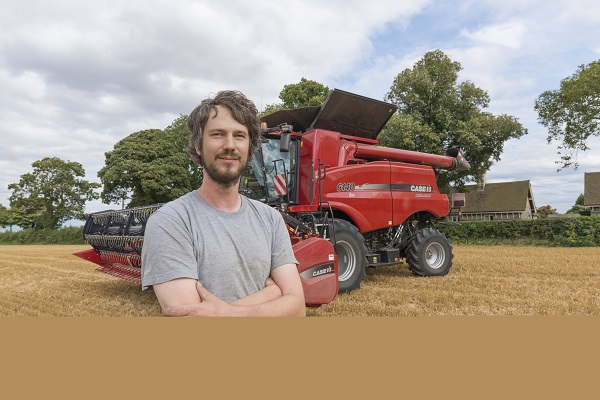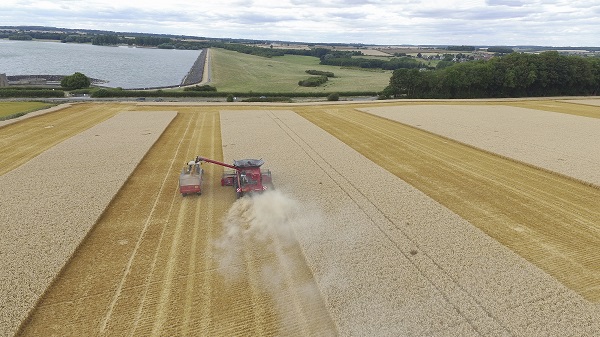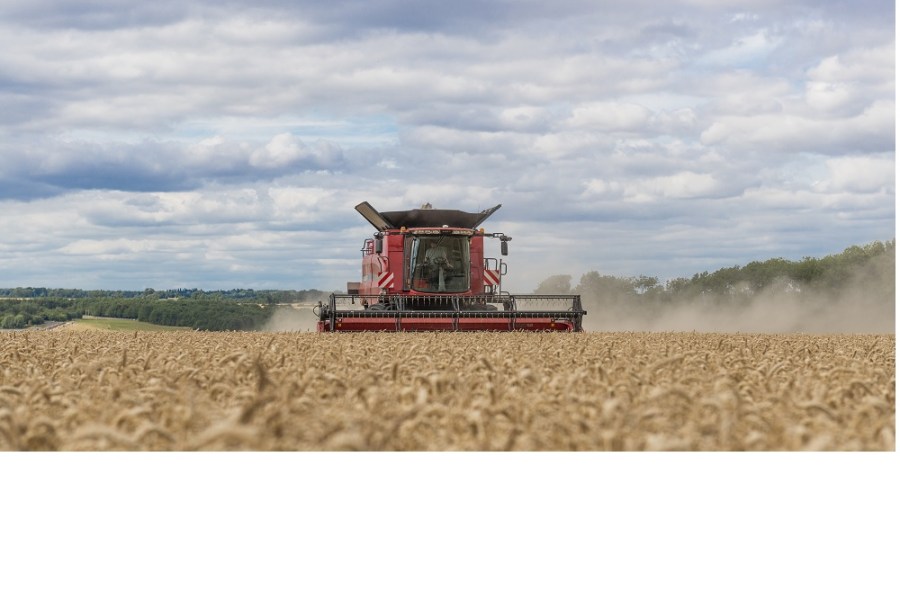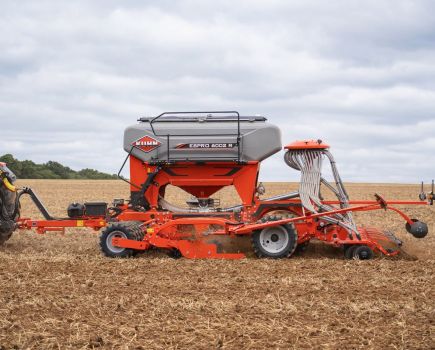Growing crops for seed demands a forensic level of attention to detail, which is just the approach one Rutland grower took when choosing his latest combine. CPM reports.
You just have to get the job right and we put a lot of time and effort into doing that.
By Julian Cooksley
At harvest time, every crop demands your attention. But for George Renner, who deals with high-grade seed direct from the breeder, attention to detail is critical, especially when he’s been entrusted with a tiny quantity of often pre-basic material.
“Sometimes we have the only field of a particular variety anywhere in the country, so there’s simply no room for error,” he notes. “You just

At every stage of the production process George Renner adopts a fastidious approach to detail.
have to get the job right and we put a lot of time and effort into doing that.”
The Renner family have been producing top-quality seed for three generations, ever since George Renner’s grandfather began working with breeding organisations such as NSDO and PBI, together with local merchants. His father, Christopher, continued the tradition at Normanton Lodge, which is situated at the eastern edge of Rutland Water and where the family have farmed since 1927.
Change in career
Determined not to be a farmer, George Renner achieved a BTEC qualification in mechanical and electrical engineering with a view to studying acoustic engineering. However, during his gap year he decided that there were worse places to work than the family farm and returned home in 1997, where he is now responsible for all of the agronomy, spraying and combining, working alongside his father and two dedicated full-time staff who are an integral part of the system.

Dealing with high-grade seed direct from the breeder, often with the only field of a particular variety anywhere in the country, there’s no room for error.
The business encompasses 325ha of mainly limestone brash, which is reliant on adequate moisture in June and July for crops to achieve good yields. Nearly all of the area is sown with seed crops on contract to various breeding companies, the aim being to achieve a good balance between yield and quality rather than outright production.
The attraction of specialising in high grade seed is the fact that it’s a premium product which not many farms have the ability to produce. With three generations of experience, the Renner family have a wealth of knowledge in this specialist area and have remained close to the breeders, putting them at the source of new genetic material.
This year’s cropping includes 110ha of winter wheat, all of which is grown directly for the breeders. The varieties comprise Group 1 bread-making wheat Skyfall, Group 3 RGT Conversion and Group 4 Belgrade, which is early to mature. The line-up of winter wheats also includes some high-grade multiplier seed of AHDB Cereals and Oilseeds Recommended List candidate RGT Knightsbridge.
Normanton Lodge also produces oilseed rape seed, all 40ha of it being Elgar for Elsoms, together with 55ha of vining peas harvested dry for seed in the form of another Elsoms variety, the semi-leafless Naches, alongside the full-leaved variety Spandimo for Daltons.
As well as seed crops, the business also produces 85ha of Marmalade golden linseed – a yellow-skinned variety that’s a commercial crop for human consumption.
All crops are direct drilled with a Dale drill, a process which started 16 years ago when wheat was fetching less than £60/t and the farm had to reduce its costs. This method has been used ever since and is an important part of establishment, as seed is often sown at very low rates due to limited availability, in bands which are 25cm apart to make hand rogueing easier and more effective.
BASIS and FACTS-qualified, George Renner takes care of all the agronomy himself, although the farm is a member of NIAB TAG and has a very good relationship with independent agronomist Patrick Stephenson.
At every stage of the production process the Renner family adopts a fastidious approach to detail. In terms of the machinery they use this starts with carefully cleaning the drill used to sow the seed, and follows right through to the combine that harvests this valuable commodity. The trailers transporting it back to the store and the drying systems must also ensure it’s in perfect condition.
“Seed production is a painstaking process and when looking for a new combine we put the same care and attention to detail into selecting exactly the right model to meet our stringent requirements,” George Renner explains.
Reliability issues
“We’d had our previous 5.1m Claas Dominator 108 for eighteen seasons, but last year it developed a couple of reliability issues and was showing its age. I was in the workshop one day, repairing it, when I received an invitation to an open evening at the Case IH dealership at Brigstock. That started the whole process.”
He looked at what Claas had to offer, but felt the modern equivalent of their Dominator looked unnecessarily complicated and impossible to clean out to the standard required.
“We researched every make and model that might potentially meet our needs, including New Holland, John Deere and Deutz-Fahr, but all incorporated some form of secondary drum separator,” he recalls.
“Eventually we concluded that nothing offered anything like the simplicity of Case’s Axial-Flow’s design, or would be as easy to clean. After spending time on two farms which owned this type of machine we had a 10m Axial-Flow 8240 to try out last year.”
They aim not to have any machinery on the farm that’s not theirs. “We’ve seen the devastating impact of blackgrass on other farms which have failed to stay on top of this very pernicious weed we’re paranoid about introducing it on our own land.
“We’ve paid particular attention to eliminating blackgrass for the past seven years and don’t have any issues with it because we walk the fields several times a year with a knapsack sprayer filled with glyphosate and kill individual plants to prevent them from seeding. We also use robust rates of herbicides to stay on top of other weeds, such as brome grass, as clean fields are an essential part of our business.”
Bringing in another combine without thoroughly cleaning it out would be out of the question, particularly a demonstrator that had been used on several other farms, he says. “So I spent two weeks going over every inch of the Axial-Flow. That gave me a very good insight into its design and how everything works, as well as a greater appreciation of the benefits of the single-rotor concept. That was underlined by driving it for the following two days harvesting linseed.”
What impressed him was the build quality. “It undoubtedly represented a big step forward over our own machine and the header handled linseed much better because it didn’t clog up or wrap around the header auger and intake.”
So George Renner and his father visited Case IH’s European Headquarters in St Valentin in Austria, to view the new Axial-Flow 6140. They particularly wanted to study the differences between the Axial-Flow 8240 which they’d tried and the new 6140 model which the company would be introducing in the UK for 2016.
As well as checking whether it would be suitable for the farm, George Renner wanted to check how the two machines differed in terms of their design. In particular, he was keen to access to every component to ensure that it could be completely cleaned out between different crops and varieties to prevent cross-contamination.
Happy with what he’d seen, George Renner compared notes with his father, who also visited Case IH’s combine plant at Grand Island, Nebraska, USA, the home of Axial-Flow production.
Key attractions
There were a number of key attractions. Along with plenty of power from its 8.7 litre 400hp FPT Stage IV engine, they liked the mechanical simplicity and ease of routine maintenance. “There’s only a handful of grease nipples to cover each day, so the job is quick and easy,” points out George Renner.
The re-designed concave also got the thumbs-up as it makes the combine easier to clean out, with slide-out composite trays at the base of the clean grain and returns augers, while the improved stone trap is useful on the farm’s brash soils. The ability to change the concaves for a particular crop, rather than relying on a compromise situation was also seen as a significant advantage. Another plus was the Cross-Flow side-hill feature that compensates for slopes.
The Renners’ new Axial-Flow 6140 Cross Flow arrived in June, well ahead of harvest, leaving George Renner plenty of time to go through the entire machine with a fine-tooth comb. In addition to sealing up any slight gaps in the grain tank and cleaning system where weed and volunteer seeds might lodge, he installed cameras to improve visibility and the GPS system from their previous combine, allowing him to concentrate on maximising the quality of the sample.
And it’s on delivering improved quality samples and a reduction in the number of cracked grains where the emphasis lies for the Renners. So how has the new Axial-Flow 6140 Cross Flow performed?
“The key thing for us, particularly in a season where the weather is difficult, is to have sufficient combine capacity so that we can harvest crops at exactly the optimum time and avoid any sprouting in the ear caused by wet or damp weather,” explains George Renner.
“The greater power and output of the new Axial-Flow mean that we can pick and choose when we operate and really push on when conditions are in our favour.
“It’s early days, but we’ve been very pleased with the way that the 6140 has performed. We started off in OSR and it handled that without any difficulty. We’ve heard some horror stories about farmers who’ve seen very low OSR yields this year, but we operate a wide rotation and didn’t experience any significant pest or disease issues and were happy when it came off at 4t/ha.
“We then moved into the peas and the new header picked them up very well. Conditions were very dry when we harvested the crop and our old combine would have caused some damage to the sample, but we had no such issues with the Axial-Flow. The only negative was that we had some difficulties fitting the lifters, which required some work to get them to fit in relation to the tine bars, but this was sorted out between the dealer and ourselves.
“Like many other growers we’ve found that this season hasn’t been the easiest in which to harvest wheat, but we’ve been able to utilise the full capacity of the Axial-Flow.”
The lack of sunlight had meant that some of the wheats haven’t ripened as early as expected, he continues. “Despite the grain being dry, down to 12%-13%, some of the straw was green or not fully ripe, so the combine had to work hard. We had to get into some crops before they were really ready, but the breeders had wanted to make sure the seed of those varieties was available and needed us to crack on to avoid weather risk so they could process the crop and get it out to growers. Despite this, there has been remarkably little damage to the grain and the Axial-Flow produced an excellent sample.”
Improvements aimed at ease and efficiency
Among the changes to 2016-model 140 Series Axial-Flow combines is the introduction of a cleaning system claimed to be more efficient with increased throughput capacity.
Following the rotor, a new six-auger bed has replaced the former five augers to convey crop more quickly to the sieves, while a new automatic side-hill compensation system optimises grain flow. The Cross Flow Cleaning System feature is activated automatically to compensate for up to 12° of lateral slope.
There are detail changes, too, such as new composite bottoms for the clean grain and tailings augers, said to make cleaning simpler and quicker, and this is aided by the combine’s on-screen ‘Cleanout’ function. Re-positioning the clean grain and tailings elevators provides easy access to the combine’s right hand side.
Six smaller and lighter concave elements make changing for different crops a quick and easy process, says Case, while repositioning the driveline on the right hand side of the combine provides easier, quicker access. Already a machine noted for few drive belts, there are even fewer on the latest Axial-Flow. Changes have been made to the ground-drive system and many comfort features of the 240 range combines have been adopted.
The new transmission offers electrical shifting between two mechanical ranges via a rotary switch on the console. Replacing the traditional gear-shift system, this method gives the operator the functionality of a semi-power-shift transmission, while the hydrostatic drive has been enhanced to handle the higher traction loads which are commonly experienced in Europe.
Other changes to 140 Series models for 2016 are designed to achieve better straw quality, for more precise spreading of chopped straw and chaff, as well as more precise swathing. Changing from swath to chopping and back also becomes an easier process. The operator has the option of changing from chop to spread and vice versa from the cab or using electrical switches mounted on the right-hand side of the combine. From here, the speed of the chopper is also changed manually without tools or belt changes.




